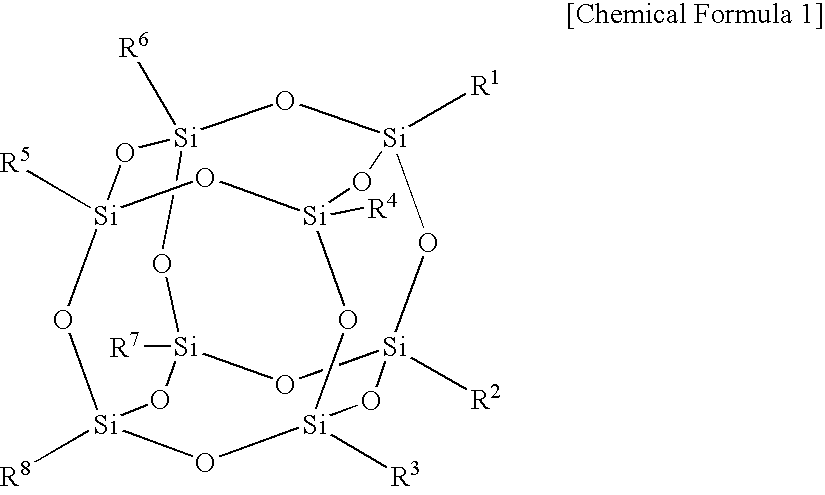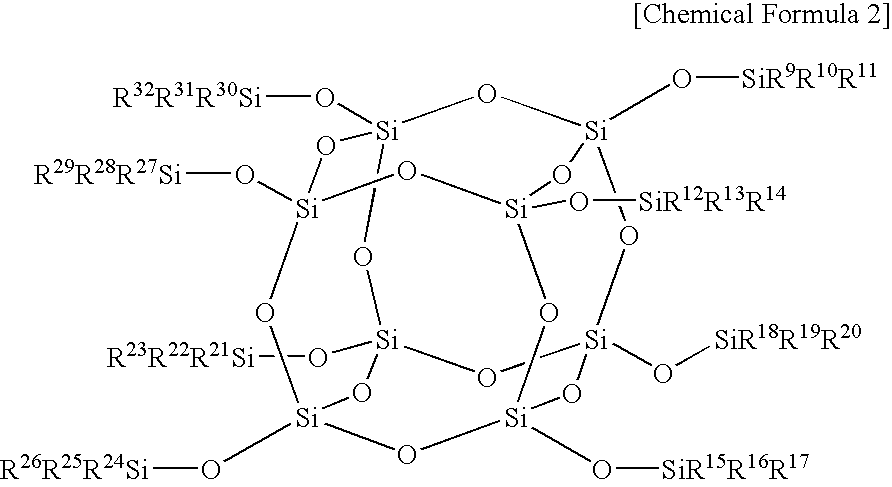Polysiloxane composition, molded body obtained from the same, and optodevice member
a polysiloxane and composition technology, applied in the field of polysiloxane composition, molded body obtained from the same, and optodevice member, can solve the problems of increasing reducing opaque cured products, etc., to achieve excellent heat resistance and light resistance, low dielectric characteristics, and workability. high
- Summary
- Abstract
- Description
- Claims
- Application Information
AI Technical Summary
Benefits of technology
Problems solved by technology
Method used
Image
Examples
examples
[0153]Next, the composition of the present invention is described in further detail on the basis of examples, but the present invention is not limited to these examples.
(Dielectric Constant)
[0154]A relative dielectric constant at 1 MHz was measured using a Q meter (Meguro Electric Co.,) under conditions of a temperature of 20° C. and a humidity of 50%.
example 1
[0166]First, 10 g of octa(vinyldimethylsiloxy)octasilsesquioxane (manufactured by Mayaterials) which was a polysiloxane having a polyhedral skeleton (silica) was dissolved in 10 g of toluene, and 30 μL of dimethyl maleate, 40 μL of 3,5-dimethyl-1-hexyne-3-ol, 40 μL of a platinum-vinylsiloxane complex (3% platinum, xylene solution), and 15 g of linear polydimethylsiloxane terminated with a hydrosilyl group (DMS-H03, manufactured by Gelest, Inc.) were added to the resultant solution and dissolved therein. The resultant solution was heated at 60° C. for 1 hour and then cooled to room temperature. Then, 40 μL of 3,5-dimethyl-1-hexyne-3-ol was added.
[0167]Then, a liquid resin composition prepared by distilling off toluene from the resultant reaction solution was poured into a mold and cured by heating at 70° C. for 30 minutes, 120° C. for 10 minutes, and 150° C. for 10 minutes to prepare an evaluation molded body of 3 mm in thickness. The various evaluation results are shown in Table 1.
example 2
[0168]First, 10 g of octa(vinyldimethylsiloxy) octasilsesquioxane (manufactured by Mayaterials) was dissolved in 10 g of toluene, and 30 μL of dimethyl maleate, 40 μL of 3,5-dimethyl-1-hexyne-3-ol, 40 μL of a platinum-vinylsiloxane complex (3% platinum, xylene solution), and 20 g of linear polydimethylsiloxane terminated with a hydrosilyl group (MHD6 MH, manufactured by Clariant Japan) were added to the resultant solution and dissolved therein. The resultant solution was heated at 50° C. for 1 hour and then cooled to room temperature. Then, 40 μL of 3,5-dimethyl-1-hexyne-3-ol was added.
[0169]Then, a liquid resin composition prepared by distilling off toluene from the resultant reaction solution was poured into a mold and cured by heating at 70° C. for 30 minutes, 120° C. for 10 minutes, and 150° C. for 10 minutes to prepare an evaluation molded body of 3 mm in thickness. The various evaluation results are shown in Table 1.
PUM
| Property | Measurement | Unit |
|---|---|---|
| thickness | aaaaa | aaaaa |
| thickness | aaaaa | aaaaa |
| light transmittance | aaaaa | aaaaa |
Abstract
Description
Claims
Application Information
 Login to View More
Login to View More - R&D
- Intellectual Property
- Life Sciences
- Materials
- Tech Scout
- Unparalleled Data Quality
- Higher Quality Content
- 60% Fewer Hallucinations
Browse by: Latest US Patents, China's latest patents, Technical Efficacy Thesaurus, Application Domain, Technology Topic, Popular Technical Reports.
© 2025 PatSnap. All rights reserved.Legal|Privacy policy|Modern Slavery Act Transparency Statement|Sitemap|About US| Contact US: help@patsnap.com


